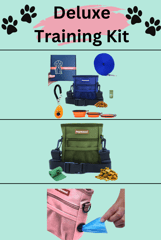I believe in educating dog owners about their breed, unlocking new levels of understanding, and taking that exciting next step together!
Decoding Dog Body Language: What Your Dog’s Tail, Ears, and Eyes Are Telling You
Understanding dog body language is essential for every pet owner. Dogs communicate through their tail positions, ear movements, eye expressions, and overall posture. A wagging tail can mean happiness or caution, while pinned ears often signal fear. Wide eyes may indicate anxiety, and a play bow is a clear invitation to have fun. By learning to interpret these signals—like raised hackles for defensiveness or lip licking for nervousness—you can better understand your dog’s emotions and strengthen your bond. This guide covers key behaviors, from tail wagging to paw raising, helping you decode what your dog is trying to tell you. Whether your pup is happy, stressed, or playful, knowing their body language ensures a happier, healthier relationship.
DOG SOCIALIZATION
Tiffany Sandquist
4 min read


Understanding Dog Body Language: A Complete Guide to What Your Dog is Trying to Tell You
Understanding dog body language is crucial for interpreting what your dog is feeling and communicating. Dogs express emotions and intentions through their posture, facial expressions, tail movements, and overall behavior. Whether you're a new dog owner or a seasoned pet parent, learning to read these signals can help you build a stronger bond with your furry friend and ensure their well-being.
In this guide, we’ll break down the key aspects of dog body language, from tail wagging to ear positions, and explain what each behavior means. Let’s dive in!
1. Tail Position & Movement
Your dog’s tail is like a mood barometer. Here’s what different tail positions and movements mean:
Wagging fast with a relaxed body – Your dog is happy, excited, and friendly. This is the classic “I’m thrilled to see you!” wag.
Wagging stiffly or slowly – Your dog is alert, cautious, or unsure. This could mean they’re assessing a situation.
Tucked tail – A tucked tail indicates fear, anxiety, or submission. Your dog may be feeling stressed or intimidated.
Raised high and stiff – This is a sign of dominance or potential aggression. Your dog is trying to assert themselves.
Pro Tip: Not all tail wags are friendly. Pay attention to the speed and stiffness of the wag to understand your dog’s true emotions.
2. Ear Positions
Your dog’s ears are another key indicator of their mood. Here’s how to decode them:
Relaxed and natural – Your dog is content and calm.
Pulled back slightly – Your dog is uncertain or submissive. They may be feeling a little nervous.
Pinned flat against the head – This is a clear sign of fear or defensiveness. Your dog is feeling threatened.
Perked up and forward – Your dog is alert, focused, or interested in something.
Fun Fact: Dogs with floppy ears, like Basset Hounds, may have slightly harder-to-read ear signals, so pay extra attention to their overall body language.
3. Eye Contact & Expressions
Your dog’s eyes can tell you a lot about how they’re feeling:
Soft, relaxed eyes with blinking – Your dog is comfortable and trusting. This is a sign of a happy, relaxed pup.
Wide eyes, showing the whites (“whale eye”) – Your dog is anxious or uncomfortable. This is often seen when they feel cornered.
Direct, hard stare – A warning sign of aggression or dominance. Your dog is challenging someone or something.
Squinting or looking away – Your dog is showing submission or trying to relieve stress.
Important Note: Avoid prolonged direct eye contact with unfamiliar dogs, as they may perceive it as a threat.
4. Mouth & Lips
Your dog’s mouth and lips can reveal a lot about their emotional state:
Relaxed mouth with tongue slightly out – Your dog is calm and happy.
Licking lips or yawning frequently – Your dog is nervous or trying to self-soothe. This is common in stressful situations.
Snarling with teeth showing – A clear warning sign. Your dog is feeling threatened and may bite if provoked.
Did You Know? Dogs often yawn when they’re stressed, not just when they’re tired.
5. Body Posture
Your dog’s overall posture can give you insight into their emotions:
Loose, wiggly body – Your dog is friendly and excited. This is often seen during playtime or when greeting loved ones.
Stiff posture with raised hackles (hair on back standing up) – Your dog is defensive, stressed, or aggressive. This is a fight-or-flight response.
Rolling onto back with exposed belly – Your dog is showing submission or seeking belly rubs. However, in some cases, this can also indicate fear.
Cowering or lowering body – Your dog is fearful or anxious. They’re trying to make themselves appear smaller.
Pro Tip: Always approach a dog with a stiff or cowering posture cautiously, as they may feel threatened.
6. Play Bowing
The play bow is one of the most recognizable dog behaviors:
Front legs stretched out, rear end up, tail wagging – This is a clear invitation to play! Your dog is saying, “Let’s have some fun!”
Fun Fact: Play bowing is a universal dog behavior that even wolves use to initiate play.
7. Paw Raising
Your dog’s paws can also communicate their feelings:
Puppies often raise a paw when curious or unsure.
Some breeds use this to ask for attention or food.
Did You Know? Paw raising is often seen in hunting breeds, like Pointers, as part of their natural instincts.
How to Use This Knowledge
By observing these signals, you can better understand your dog’s emotions and prevent potential issues like stress, fear, or aggression. Responding appropriately—whether by reassuring a nervous pup or respecting a warning sign—helps strengthen your bond with your dog.
Here are some practical tips:
Pay attention to context. A wagging tail doesn’t always mean happiness, and a growl doesn’t always mean aggression. Look at the whole picture.
Respect your dog’s boundaries. If your dog shows signs of stress or discomfort, give them space.
Use positive reinforcement. Reward calm, relaxed behavior to encourage your dog to feel safe and secure.
Final Thoughts
Understanding dog body language is an essential skill for any dog owner. By learning to read your dog’s signals, you can ensure they feel safe, loved, and understood. Whether your dog is wagging their tail in excitement or rolling over for belly rubs, every behavior tells a story.
So, the next time your dog tilts their head or raises a paw, you’ll know exactly what they’re trying to tell you. Happy bonding with your furry friend!













Sit Happens Here
Transforming lives through dog training excellence.
Contact Us
971-218-9622
© 2024. All rights reserved.
